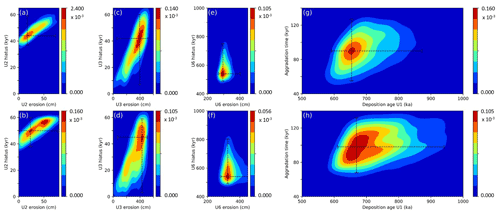Link to full text
https://doi.org/10.5194/gchron-4-713-2022
Authors
Nathan Vandermaelen, Koen Beerten, François Clapuyt, Marcus Christl, and Veerle Vanacker
Citation
Vandermaelen, N., Beerten, K., Clapuyt, F., Christl, M., and Vanacker, V.: Constraining the aggradation mode of Pleistocene river deposits based on cosmogenic radionuclide depth profiling and numerical modelling, Geochronology, 4, 713–730, https://doi.org/10.5194/gchron-4-713-2022, 2022.
Abstract
Pleistocene braided-river deposits commonly represent long periods of non-deposition or erosion that are interrupted by rapid and short aggradation phases. When dating these sedimentary sequences with in situ-produced cosmic radionuclides (CRNs), simple concentration depth profiling approaches often fall short, as they assume that the alluvial sedimentary sequence has been deposited with a constant and rapid aggradation rate and been exposed to cosmic radiations afterwards. Numerical modelling of the evolution of CRNs in alluvial sequences permits one to account for aggradation, non-deposition and erosion phases and can simulate which scenarios of aggradation and preservation most likely represent the river dynamics. In this study, such a model was developed and applied to a Middle Pleistocene gravel sheet (Zutendaal gravels) exposed in NE Belgium.
The model parameters were optimised to the observed 10Be and 26Al concentrations of 17 sediment samples taken over a depth interval of 7 m that constitutes the top of a gravel sheet up to 20 m thick. In the studied sedimentary sequence, (at least) three individual aggradation phases that were interrupted by non-deposition or erosion can be distinguished, each interruption lasting ∼ 40 kyr. The age for the onset of aggradation of the upper 7 m of the gravel sheet was further constrained to ka. This age, within error limits, does not invalidate previous correlations of the gravel sheet with the Cromerian Glacial B and Marine Isotope Stage (MIS) 16. The deposition of the entire gravel sheet likely represents more than one climatic cycle and demonstrates the importance of accounting for the depositional modes of braided rivers when applying in situ cosmogenic radionuclide techniques.


